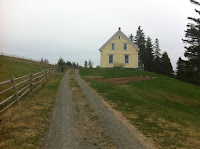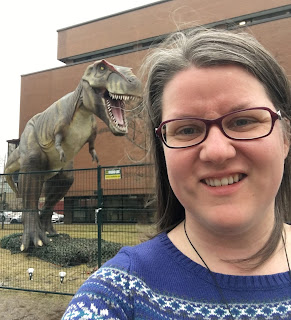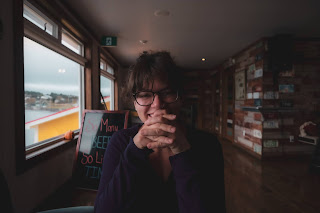 |
Marven and Barry evaluating
underground at the Cape
Breton Miners Museum |
Museum Evaluation ProgramSite Evaluations are done! Phew, what a ride. We had beautiful weather until the very last day, andreally enjoyed getting out and reconnecting with everyone in person. Evaluators said it was very noticeable when museums saw COVID as an opportunity, and that this year most museums were really prepared for their evaluation. I also noticed a lot of really great initiatives, interpretive elements, and other ideas that just had to be shared, so check out our
Facebook album of this year's evaluations. You never know, you might pick up an idea or two for your own museum. Each image has a brief description so you'll know what caught our attention.
The next part of the evaluation process is to tabulate the results and compile them into reports for each of the 27 museums participating this year. Since this is a formal program, we will mail the reports out on September 10th, and when they are received you can request a pdf copy.
 |
Shannon from Dartmouth Heritage
Museum photographs a large rug
during a hub training session |
Site Visits and Hub TrainingIt's been a very busy month of travels for Emma. She has now visited with staff and volunteers at 48 Advisory Service sites from Cape North to Yarmouth. Of these, 30 of them were in person and 18 were virtual. The final site visits will be completed in the next few weeks. While on the road she's digitized a wide range of domestic textiles, including many larger items - quilts, curtains, and large hooked rugs. We have one final hub training session on how to digitize domestic textiles taking place on Tuesday, August 3rd at 10am. It is 2 hours long and taking place via Zoom. If you are interested please register asap by
clicking here.
CollectiveAccess Updates
Thanks to everyone who completed our survey on condition reporting. We got some great info. Sarah and Karin are now working with Seth at Whirl-i-gig to come up with a development plan for the condition reporting feature, and we hope to start the mock-up within the next few weeks.
As we mentioned last month, with so much work happening in the databases over the summer, it is incredibly important to have good training and quality assurance measures in place. While most museums are doing well with this, today we found five that are not. Please please please keep an eye on the work of your staff and volunteers. It is so frustrating to not be able to find something in your database, and to have to spend time correcting work rather than moving forward. If you or they have questions, reach out to us any time. We are happy to help.
Here is how things stand across the province:
Southwest: 144,187 artifacts, 99,715 images
Central: 105,767 artifacts, 93,379 images
Northeast: 54,350 artifacts, 73,820 images
Cape Breton: 32,788 artifacts, 24,765 images
Congrats to the Southwest region for adding the most records and images this month!
Your image lesson of the month is a musical one. Here we have an accordion, an object that can be a bit tricky to photograph. So let's review our basic rules:
1 - Ensure your backdrop is smooth and clean. Wrinkles and creases are visible and detract from the overall image quality, so before you start your photography session be sure to iron the fabric and remove any lint, dust or dirt.
2 - Photograph the object in its natural position. In this case, you would want to rotate the accordion so the handles/ends are on the left and right sides rather than top and bottom.
3 - The scale should not obscure the object nor the object the scale. The way this photo was set up, parts of the scale are hiding underneath the accordion. The scale should be pulled out from underneath so that it is included in the frame of the photo.
4 - Centre the object in the frame. Do you notice how your eye sort of drags to the right because the object isn't in the centre of the image? Be sure to include a small and even backdrop frame for the object. The scale gets incorporated into this frame.
5 - Take additional photos as appropriate. In this case, If the accordion were still in good, flexible, playable condition (no I am not encouraging you to play the instruments in your collection), I would open it a bit to take a second shot that demonstrates how the bellows look while being played, curving it slightly as players do. There are also some nice decorative details in the bellows, so taking a close-up detail shot of the design would be worthwhile. And as usually, a front, back, and side view is a good idea for 3-dimensional objects.
NovaMuseEd
As we mentioned last month, the end of the school year has resulted in a drop in NovaMuseEd use, but it is still very active. This month we added another learning activity, Storytelling Through Folk Art, which is proving to be quite popular. And Emma has been gathering a lot of school program files during her travels so we are well-positioned to keep adding to this resource.
In publicity news, our two proposals to share NovaMuse at fall conferences have been approved! And oddly enough, they're on the same day! In October we will be presenting at both the Nova Scotia Social Studies Teachers Conference and our joint conference with Museums, Archives and Libraries. We're really looking forward to getting the word out there and celebrating your and our hard work.
 |
| SME enrichment of domestic textiles |
Educational PartnershipsIt's hard to believe how quickly the summer is flying by. Sarah's time with us is soon coming to a close, but she's still hard at work. This month she worked with two SMEs on blanket and hooked rug records and will be sending reports out to museums whose information was enriched. So far 28 records have been enriched from 11 museums. Keep in mind that when we do our SME work we simply follow the artifacts, so this is another reason to make sure that you have good records and good images in your database.
Sarah has also continued with her entity reconciliation work and we've now completed 40 of 56 museums' databases! We're amazed by how much Sarah has accomplished this summer and to be honest we don't want her to leave! But we are always looking ahead, and next week will be setting up interviews for a fall intern from MSVU. Yes that's right, this means this student will be focusing their efforts on NovaMuseEd. With our stockpile of resources, ideas, and requests from teachers, there is no shortage of work for them to tackle.
That's all for this month folks! Keep up the great work, stay tuned for more announcements and news, and stay dry out there. What a rainy Friday!






























